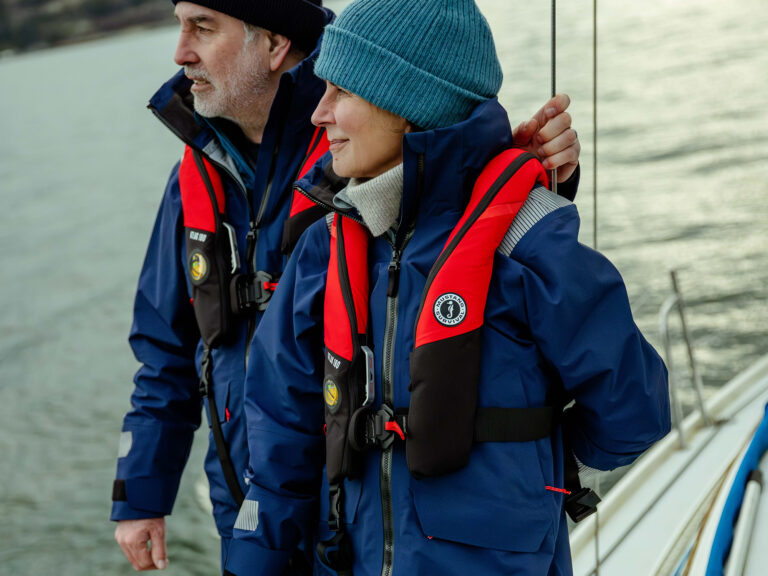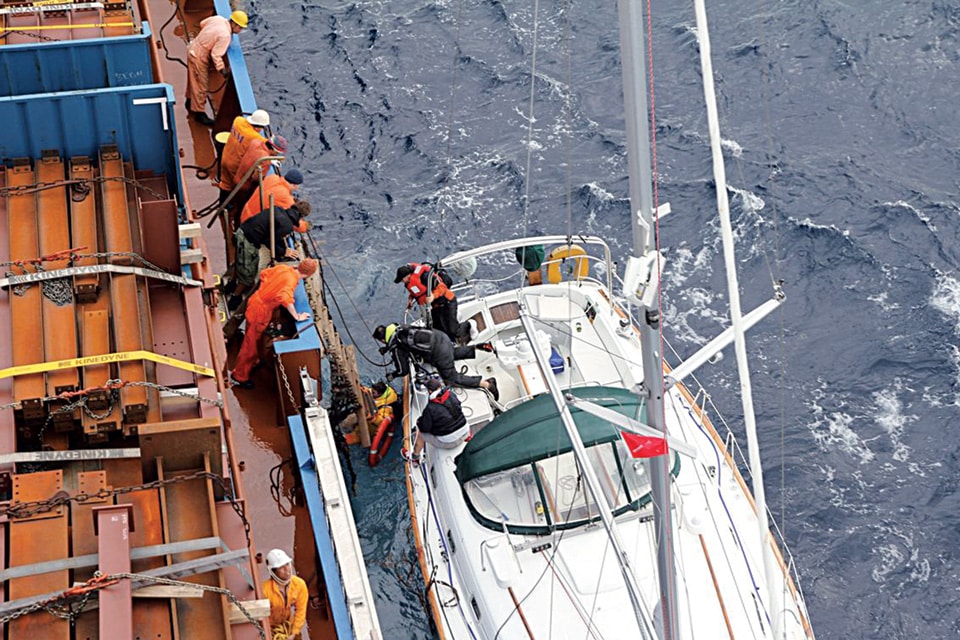
Sailboat Elle’s Rescue at Sea
Here’s the scenario: You’re several hundred miles offshore in the Atlantic Ocean en route to the Caribbean when conditions turn nasty. Your three crew and you endure two days of 40-knot winds and 20-foot seas. On the third day, important gear starts breaking, and two of your already exhausted crew are incapacitated. Sensing that you’re in serious trouble, you activate your EPIRB and request a rescue from the U.S. Coast Guard.
Your fate is no longer in your own hands.
Once communications have been established, you learn that you’re out of range for a helicopter rescue, which you’ve seen numerous times in videos, and even witnessed firsthand during a Safety at Sea Seminar. Instead, the Coast Guard informs you that it’s putting out a call to vessels in your vicinity registered with Amver, the Automated Mutual Assistance Vessel Rescue System, a voluntary global ship-reporting system used by search-and-rescue authorities to arrange for assistance for mariners in distress. You’re about to be rescued by an enormous freighter or tanker.
Do you know what you’re in for? Probably not. In hindsight, many sailors who weren’t in imminent mortal danger second-guess their decision to call in the high-seas cavalry. That’s because, during several recent ship-assisted rescues that resulted in near-fatalities, it became clear that cruisers and racers alike weren’t adequately prepared for the experience. Furthermore, there’s currently very little to remedy this situation in today’s standard safety training.
Knowledge, risk, exertion and responsibility represent the four most fundamental and critical differences between a helicopter-assisted rescue and a ship-assisted rescue. With a helo-assisted rescue, there is a single method of transfer: the basket hoist. You get in the basket, you go home. In terms of risk, we’re comfortable knowing that this transfer method has been tested and perfected over many years and is relatively safe once you’re in that basket. Even an incapacitated sailor can make this transfer once he or she is in the basket, which can even be returned to the sailor by the helo pilot and rescue swimmer if it happens to drift away.
Clearly, we know a lot about helo-assisted rescue, which is valuable in the midst of a chaotic situation. There’s also a significant bonus to this scenario: The best rescue assistance on the planet is right there with you. Because it’s the primary responsibility of the Coast Guard personnel to get you and your crew safely ashore, you don’t need to think and plan during the transfer process nearly as much as you need to listen and follow directions. As skipper, your level of responsibility is reduced.
Not so with a ship-assisted rescue.
Where the fundamental responsibility of a Coast Guard helicopter crew is rescue, the primary exercise of a ship’s captain and crew is to transport cargo as quickly and economically as possible. The core missions are vastly different, which means that everything is different.
Therefore, as skipper, your level of responsibility in a ship-assisted rescue is astronomically higher than with a helo-assisted rescue. It’s up to you and your crew to make it to the deck of that ship with limited assistance. In essence, you, the skipper, become the “rescue swimmer” in a ship-assisted rescue.
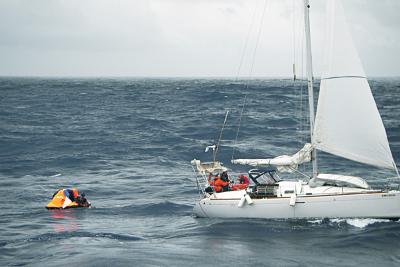
| |
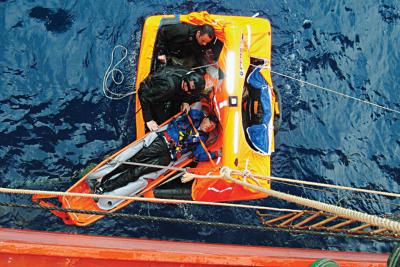
| |An emergency beacon set off 3,000 miles east of Hawaii triggered a combined-assets rescue of an injured crewmember, who was loaded into a life raft, transferred to a litter, then hoisted aboard the Amver vessel Cap Palmerston. Aiding in the rescue was a Coast Guard C-130 search aircraft and pararescuemen from the Coast Guard’s 129th Rescue Wing.|
My interest in this issue began when I came across a rare firsthand recounting of a harrowing ship-assisted rescue on an online sailing forum. Skipper Doug Sabbag of the Gulfstar 50 Triumph nearly drowned in the summer of 2011 due to a miscommunication during a ship-assisted rescue with a 900-foot tanker, the Kim Jacob. Sabbag struggled for three hours in rough seas after jumping from his boat in an attempt to swim to the ship. He admitted that he was very lucky to survive.
My curiosity piqued, I began to research the topic and quickly found accounts of five ship-assisted rescues that occurred in 2011 alone, two of them in that year’s North American Rally to the Caribbean, or NARC (see “Hard Lessons Learned in the North Atlantic“). One of these incidents involved a 46-footer called Elle; during the rescue, one of the crew was nearly crushed between the vessels after falling into the sea during his transfer. It became clear that the frequency of ship-assisted rescues points to the need for better understanding and training. So too does the inherent danger, best summarized by Capt. Evans Hoyt of Norwegian Cruise Line, who said, “Like getting into a life raft, you shouldn’t make the decision to abandon your boat and board a ship in other than perfect conditions unless you feel that you’re at risk of dying, because the danger of the transfer is greater than the danger of staying on a viable and still-afloat vessel.”
Capt. Hoyt is very clear. Due to the extreme dangers and challenges common to these transfers, this type of rescue is only a last-ditch option when death is imminent. The lack of general knowledge and preparedness regarding ship-assisted rescue is an issue for offshore sailors as well as the good souls aboard Amver vessels who voluntarily come to their rescue. It’s a problem that needs a solution.
In the online discussion about the near tragedy aboard Triumph, some sailors suggested that standardization of equipment and procedures for all Amver participants is the place to start. But what stood out to me in these discussions was the lack of responsibility assigned to those on the other side of the equation: us sailors. The captains and crews of ships already undergo a great deal of mandatory rescue training and equipment inspection. What about us? Are we really doing our part to alleviate the risk in this age-old commitment of performing rescues at sea?
Quite simply, when it comes to education and training, unless you’re an offshore racing sailor who must take a mandatory Safety at Sea Seminar to participate in specific events, the answer is no. And even if you do enroll in one of the sanctioned seminars, there’s a dearth of specific training or instruction regarding ship-assisted rescues.
Since the skipper and crew of a sailboat are, in fact, a critical part of the rescue team in such a scenario, no solution is complete without our commitment as sailors to better prepare ourselves. However, such information has just not been available. Fortunately, that’s changing.
Benjamin Strong, the director of maritime relations for Amver, says the U.S. Coast Guard is currently in discussions with other international search-and-rescue organizations to develop more standardized means of recovery in ship-assisted rescues. So the “rescuers” are certainly proactive on their side of the equation, which means it’s time that we sailors raise our game too.
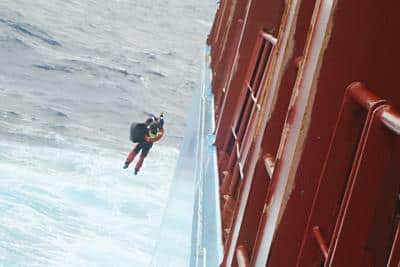
| |Sailor Gianfranco Tortolani is hoisted aboard the Amver vessel Maersk Missouri after his sailboat capsized and was dismasted 300 miles from Halifax, Nova Scotia.|
With that in mind, let’s examine the unfolding of a likely rescue scenario, such as the one described at the outset of this story. As the boat’s skipper, you represent the primary point of what’s known as the “rescue triangle”; the other two points are the Coast Guard’s SAR controller and the captain of the rescuing ship. All rescue communications, risk assessments, strategies, preparations and actions will pivot around you. Here are the issues you’ll need to address or consider.
Timing and judgment are critical: Before initiating a rescue request, assess your boat, the crew, the conditions and yourself. The conclusions from this evaluation should be dire enough to outweigh the very real difficulties and risks that will come with transferring, with limited assistance, everyone to a ship in the open ocean. Also understand that the ship may take a day or two to arrive. Factor that in before making your call.
The Coast Guard will help evaluate the conditions: Once the Coast Guard receives your distress call and position, ideally via EPIRB, the SAR controller will attempt to establish direct communications with you. (Before heading offshore, of course, make sure your EPIRB registration information is correct and current; also file a float plan with a friend or relative, along with a photo of the boat for identification purposes.) Iridium or Inmarsat satellite phones are the best communication options, followed by SSB radio. Once communications have been established, the controller will assist you in making the right calls. Make use of these rescue professionals by having the right equipment on board, including an AIS transceiver and a SART transponder to assist the ship’s captain in locating your vessel.
Be committed to the decision: The controller will know immediately whether you’re in helicopter range or will require Amver assistance, and within minutes he or she will have identified the ships in your vicinity. Once the controller contacts the optimum vessel, it’s time to commit by preparing yourself, your crew and your boat for what’s ahead.
The countdown begins: Once the ship has been diverted, the controller will set up a communications schedule with you while simultaneously communicating with the ship’s captain. Though the controller will relay such critical information as ETA from the captain to you, until the ship gets into radio range, you’ll likely be in on only one side of that conversation.
Start to plan and prepare: This is the most critical time for you and your crew. With the ship steaming toward you and with the controller acting as both your rescue advisor and communications intermediary, begin to assess such details as the ship’s configuration (so, for example, you can estimate the height from your boat to the ship’s deck), the likely transfer method (via, say, Jacob’s ladder, line and hoist, or cargo net), and how these factors align with the condition and abilities of you and your crew. Though factors may change when the ship arrives, you need to have an initial plan of action coordinated among the three points of the rescue triangle.
Consider these questions: Does your boat still have propulsion, which can be extremely useful when coming alongside the ship? If your engine is disabled or your boat is sinking, does it make more sense to stage the transfer from a life raft or an inflatable, while acknowledging that these present their own challenges in rough seas? What should you take and what should you leave behind? For example, did you know that the Coast Guard asks that you take your EPIRB with you to prevent false alarms from the drifting boat after your evacuation? Do you have your passport, cash and a credit card? Have you packed so both hands can remain free to deal with an arduous transfer?
The ship comes into range: As the ship comes into radio range, the controller will go into standby mode and relinquish the primary communications to you and the captain. Be aware of potential language issues that might cause problems. Though the controller may be able to assist with translation if necessary, it’s far better to have direct communication with the ship to ensure that no mistakes are made. Misunderstandings and assumptions can be fatal, so clarity is key. Once the captain has assessed the situation, review the agreed-upon transfer plan in as much detail as possible. Make sure that you and your crew are comfortable with the plan, because once the operation begins, the captain is in charge. Your responsibility shifts solely to making sure that your crew, and then you, safely negotiate the transfer to the ship.
Be patient: Though you will most likely speak only with the captain during the transfer, understand that he in turn will be communicating with key personnel aboard his ship, each with a specific role in the rescue. Remain patient as the captain works through this complicated chain of communication. Be deliberate and clear with each request, statement and command.
The transfer, step 1: The captain will most likely position his ship broadside to the wind and seas to create a lee, then drift down toward your boat. This will take time. If you still have a working engine, it will aid in the process, but be sure to coordinate all movements with the captain. You and your crew should be wearing PFDs and be tethered to the boat, with fenders out and a boat hook handy to grab lines or to fend off. As skipper, stay focused on the communications and your directions to your crew while they address the tasks at hand.
The ship’s crew should have the agreed-upon means of transfer in place and will likely launch a small messenger line to your boat. Use the boat hook, if necessary, to retrieve this line, which will be fastened to a heavier line to connect your boat to the ship. Secure this heavier line to the mast and a cleat. The ship’s crew will haul your boat toward the ship. In a seaway, it will become increasingly hazardous as the two vessels converge. You and your crew should be focused on the means of transfer and be ready to go when the word is given.
The transfer, step 2: Don’t rush anything. The ship’s crew will be patient and will exhaust every possibility to ensure a safe transfer for each person. For this exercise, let’s assume the transfer will occur by means of a Jacob’s ladder. Make sure your boat’s mast is as far away from it as possible. The ship’s crew will work to keep your boat in place, but it’s up to you to make sure that the climbing path is clear. If possible, all should stay tethered to the boat until it’s their turn to climb. When the climber unclips his or her tether (leaving it attached to the boat, not dragging it along), one or two others should help to steady the ascending sailor on the ladder. When you’re climbing, take a moment to carefully time the rise and fall of the boat and the distance to the ladder; at the wave’s crest, reach out and take strong hold of the ladder’s side rails or lines while placing a foot on a rung. Be careful — the ladder may be slippery. As your boat falls away, immediately climb to safety. In some instances, the ship’s crew may be able to hoist the ladder, but explore that option ahead of time. Repeat until everyone is safely aboard the ship; the skipper should be last to go. Remember, as fewer crew are aboard to assist each climber, the entire procedure becomes increasingly difficult. Plan accordingly.
Aboard the ship: Once you’re safely aboard, deactivate your EPIRB and evaluate the condition of your crew and yourself. The ship’s crew may not have much medical experience, but they can contact a physician if necessary. Understand that you’re a guest aboard this working vessel, which has just lost a good deal of time and money rescuing you. The captain must resume course as quickly as possible to a destination that may be far from your original itinerary. Investigate lodging and transportation options for when you reach port. Most important, thank those who have just upheld the honor-bound tradition of performing a rescue at sea.
A Texas-based cruising sailor and ocean racer, Steve Brothers wishes to thank, in addition to those already mentioned, the following sailors for their assistance with this article: Ron Trossbach, the U.S. editor of the International Sailing Federation’s Offshore Special Regulations_; Safety at Sea seminar moderator Sheila McCurdy; Geoffrey Pagels of the U.S. Coast Guard; Captain John A. Konrad V; and Beth Leonard and Evans Starzinger. This article first appeared in the November 2013 issue of_ Cruising World_ as “The Freighter’s Here! Now What?”_






